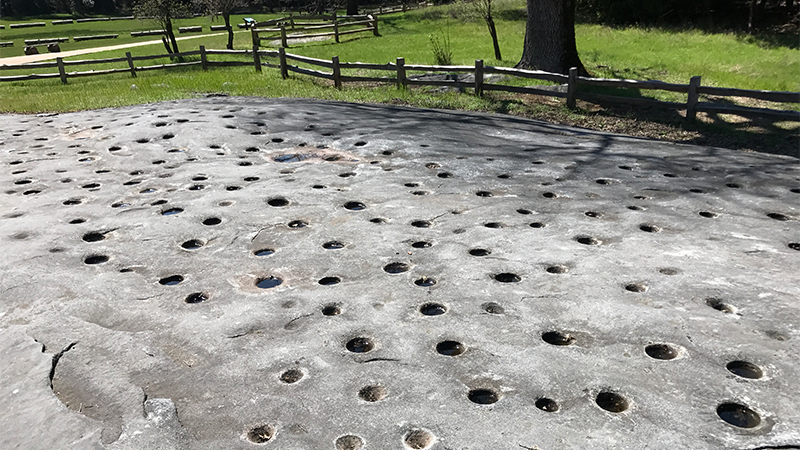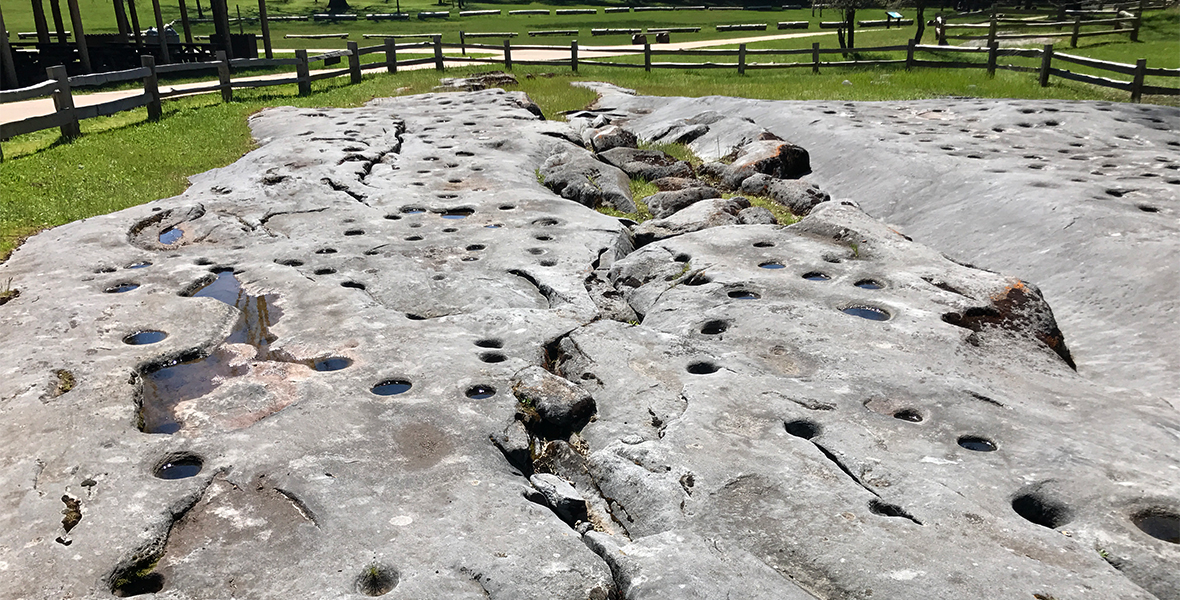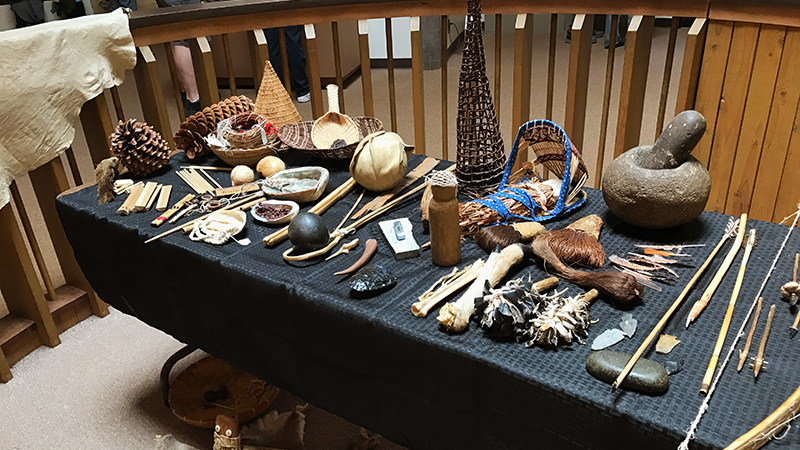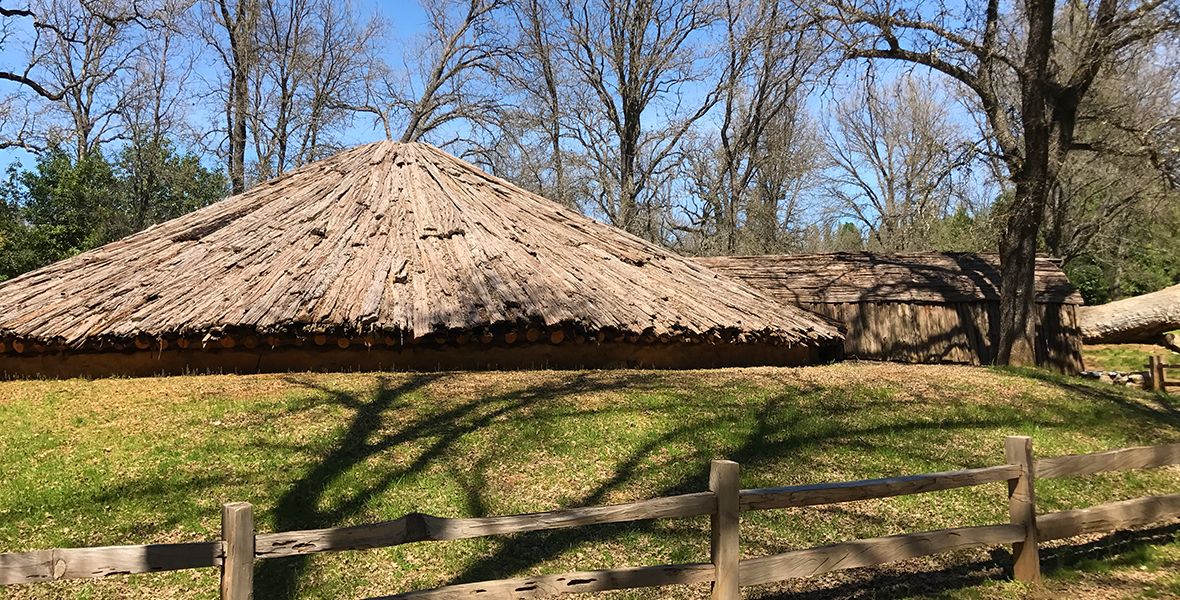
I have wanted to visit McLaughlin’s Daffodil Hill for several years, and this year we finally timed it right to visit the sprawling farm covered in Daffodils, but our whole visit only took about 90 minutes, so after that we were on the hunt for other things to do around Volcano and Pine Grove. After Daffodil Hill, we did the spectacular walking tour at Black Chasm Cavern, and then after a picnic lunch, stopped at Indian Grinding Rock State Historic Park.
Indian Grinding Rock State Historic Park is located in the Sierra Nevada foothills, eight miles east of Jackson. The park, listed on the National Register of Historic Places in 1971, is nestled in a small valley 2,400 feet above sea level with open meadows and large valley oaks that once provided Native Americans with an ample storage of acorns.
The 135 acre park preserves an outcropping of marbleized limestone with 1,185 mortar holes — the largest collection of bedrock mortars anywhere in North America.

Chaw’se Regional Indian Museum
The two-story Chaw’se Regional Indian Museum was our first stop at the park. The museum showcases examples of the technology and crafts of Sierra Nevada Native American groups, as well as examples of basketry, feather regalia, jewelry, arrow points, and other tools. The collection at Chaw’se includes artifacts from Northern, Central, and Southern Miwok, Maidu, Konkow, Monache, Nisenan, Tubatulabal, Washo, and Foothill Yokuts.
The museum is small, but very well done, and there are some hands on exhibits where visitors can try a hand drill and a mortar and pestle.

The Grinding Rock And Petroglyphs
Chaw’se is the Miwok word for the mortar cups that formed in a stone slab as the Miwok people pounded acorns and other seed into meal. The largest Chaw’se example in North America can be seen at the park. The main grinding rock also features 363 petroglyphs thought to be two or three thousand years old, including circles, animal and human tracks, and wavy lines, but they are slowly becoming difficult to see.
There is an accessible wooden viewing platform that extends over the largest grinding rock and gives you a fantastic view of the mortars and maybe the petroglyphs. While seeing the mortars is easy and obvious, we looked really closely and were only able to make out one or two petroglyphs.
When standing on the platform, it’s pretty amazing to see all of the mortar holes and to think how much work and effort happened to create those holes over long periods of time, especially after trying out the grinding of acorns and seeds with a mortar in the museum!

The Village And Roundhouse
A reconstructed Miwok Village, including bark houses, a ceremonial roundhouse, acorn granaries, shade armadas, and an Indian game field provides present-day Miwok descendants with an opportunity to preserve their heritage and share it with future generations of Californians.
The park’s Roundhouse, one of the largest in California, is typically the center of a Miwok village, acting as the community center for social gatherings and ceremonial events. The semi-subterranean building was the largest in the village and had a hole in the center of the rook to allow smoke from the fire pit to escape. The Roundhouse is registered as a California Historical Landmark and is closed to the public because it is still used as a ceremonial site. There is a smaller Roundhouse behind the large one however, and while you can’t go inside, you can peek inside.
A few Miwok homes, called bark houses, are found near the grinding rock and also at the reconstructed village west of the Roundhouse. The homes were built of cedar poles interwoven with grapevines or willow, and covered with cedar bark. A hole was left at the top for venting smoke from cooking or heating fires.
We all enjoyed being able to go inside the bark houses and explore them on our own, instead of just looking at them from behind a fence.
A game field has also been reconstructed near the Roundhouse with displays explaining a game played my the Miwok that was similar to soccer, but with different rules for men and women. Men could only kick the balls, but women could could handle the ball in any manner… but if a woman held the ball, a man could pick her up and run for the goal! (We all were cracking up while imagining a man just picking up a woman with the ball and running down the field!)
Hiking And Picnicking
There are two developed trails at Chaw’se Indian Grinding Rock State Historic Park:
- The North Trail is a one-mile round trip trail that starts near the museum, traverses the ridge surrounding the meadow, crosses the creek, passes by an old farm site, and continues to the Miwok village site.
- The South Nature Trail is a half-mile loop trail that starts near the Roundhouse, passes the Miwok Village, and takes you through the brush and native pants, on your way back to the Roundhouse.
When you’re done hiking, there are public picnic tables near the museum entrance and covered picnic tables (hooray for shade) near the grinding rocks and the game field.
We explored the park, hiked the trails, and snagged a few waters from the ice chest for the ride home, still talking about how amazing all of the mortar holes in the grinding rock were.
Know Before You Go
- Indian Grinding Rock State Historic Park and the Chaw’se Regional Indian Museum are located at 14881 Pine Grove-Volcano Road, Pine Grove, California 95665 near Daffodil Hill and Black Chasm Cavern in Amador County.
- Day use fee is $8.00 per vehicle. Admission to the museum is free with paid park admission.
- Park hours are sunrise to sunset, but the museum hours are 10:00 am to 4:00 pm daily, closed Thanksgiving Day, Christmas Day, and New Years Day.
- Download the park brochure.
- There is a small gift shop in the museum that is managed by the Chaw’se Indian Grinding Rock Association.
- The marble grinding rock is fragile and susceptible to chipping. The natural elements are already claiming many of the petroglyphs, so please stay off the rock and respect the critical pieces of Miwok history this represents.
- There isn’t much shade to be found at this park, so if you’re visiting on a sunny day, be sure to wear a hat or bring sunscreen. Also, if it’s warm, bring along water for your entire family.
- Pack a picnic! There are shaded public picnic tables in the park that are perfect for enjoying a nice family picnic after hiking on the park’s trails.
- The park has 23 campsites with paved parking for vehicles up to 27 feet that are open year-round. They have tables, food lockers, fire rings, piped water, and restrooms with flush toilets and showers.
- You can camp in a bark house in the U’macha’tam’ma’ Environmental Living Group Camp! Seven bark houses that each fit up to six people offer a primitive camping experience and can be reserved for a group of up to 44 people.
- Except for service animals on a leash, dogs are not permitted on the trails.











